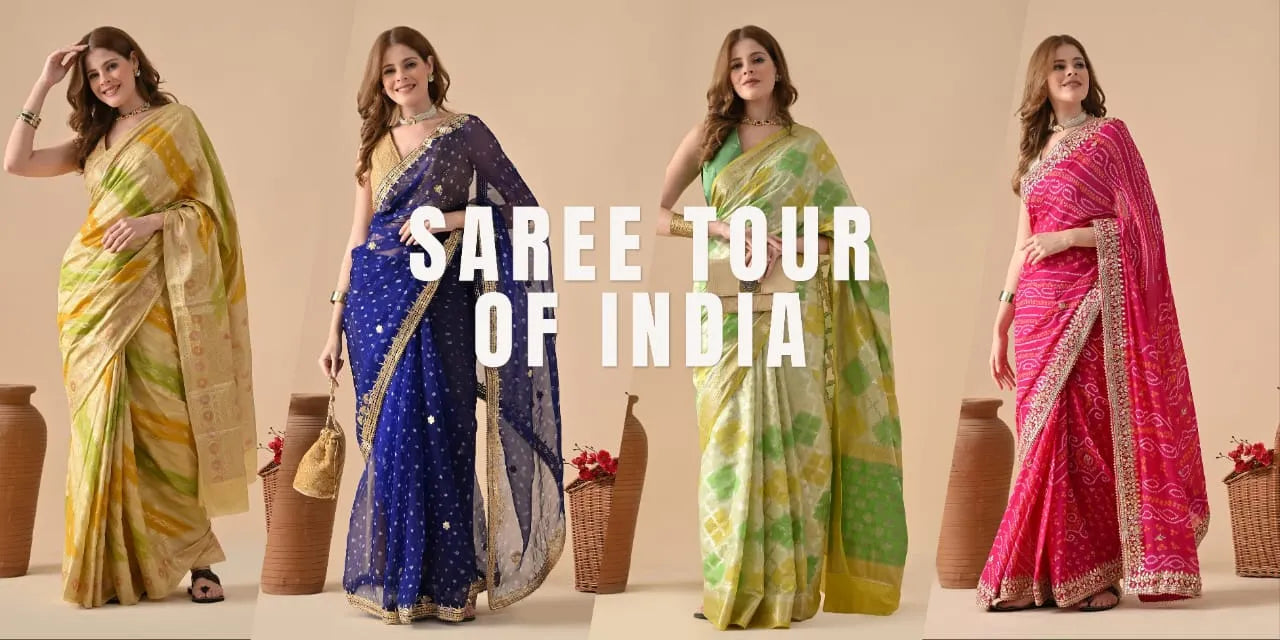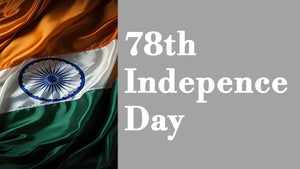India's diversity is beautifully reflected in its textiles, especially in the timeless drape of the saree. Every state offers a distinct story woven into fabric, making sarees not just attire but a living embodiment of culture, tradition, and craftsmanship. The saree is more than just a piece of clothing; it is an identity, an art form, and a connection to heritage. Here, we bring you 28 exquisite sarees from 28 Indian states a journey across India in six yards.
1. Andhra Pradesh – Uppada Silk Saree
Originating from Uppada village, these sarees are known for their lightweight silk and delicate zari work. The weaving technique allows intricate designs while keeping the saree light and comfortable. They are luxurious yet breathable, ideal for weddings, traditional events, and festive gatherings.
2. Arunachal Pradesh – Apatani Cotton Saree
Minimalist in design, the Apatani saree is woven using backstrap looms with tribal stripes and geometric patterns. Made by the Apatani women, these sarees reflect the sustainable lifestyle and earthy aesthetic of the region. They are perfect for eco-conscious ethnic fashion lovers.
3. Assam – Muga Silk Saree
Muga silk, exclusive to Assam, is renowned for its natural golden sheen and durability. These sarees are heirloom-worthy and symbolize Assamese pride. Traditionally worn for Bihu and weddings, they exude royal charm and timeless elegance.
4. Bihar – Bhagalpuri Tussar Silk Saree
Made from Tussar silk, these sarees are earthy, eco-friendly, and perfect for formal and casual wear. Their textured feel makes them stand out, while natural dyes give them a rustic charm. Often adorned with minimal embroidery or prints.
5. Chhattisgarh – Kosa Silk Saree
Kosa silk sarees have a matte finish with tribal motifs, showcasing the craft heritage of Bastar artisans. These sarees are known for their coarse texture and natural appeal. Their understated beauty makes them suitable for both daily wear and special occasions.
6. Goa – Kunbi Saree
Red checks and simple borders define this traditional tribal saree. Once nearly extinct, it's now revived as a cultural symbol of Goa. Often worn by the Kunbi women, the saree reflects simplicity, strength, and pride in regional identity.

7. Gujarat – Patola Saree
A double-ikat marvel from Patan, Patola sarees are complex in weave and vibrant in design, often featuring geometric patterns and folk motifs. These sarees require immense skill and time, often taking months to weave. They are treasured as symbols of status and heritage.
8. Haryana – Resham Dhuria Saree
These sarees feature silk embroidery on cotton or chiffon, representing rural artistry and festive wear of Haryana's countryside. They combine comfort with celebration, often showcasing floral and bird motifs in bright colors.
9. Himachal Pradesh – Chamba Rumal-Inspired Saree
Inspired by the famous embroidered Chamba Rumal, these sarees often depict miniature Pahadi paintings and floral scenes. They are hand-embroidered with intricate detailing, often telling stories through thread.
10. Jharkhand – Tribal Tussar Saree
Handwoven with organic dyes, these sarees are raw and artistic. Motifs reflect the daily lives and beliefs of the tribal communities. They're sustainable, naturally dyed, and deeply rooted in the region's soil.
11. Karnataka – Ilkal Saree
Woven with cotton body and art silk or pure silk borders, Ilkal sarees are identifiable by their red-tinted "tope teni" pallu and durability. They're practical for daily wear yet stylish enough for traditional occasions.
12. Kerala – Kasavu Saree
White or off-white saree with gold borders, the Kasavu is elegance personified. Worn during festivals like Onam and weddings, it's symbolic of purity. The gold zari adds understated grandeur to its simplicity.

13. Madhya Pradesh – Chanderi Saree
Lightweight and glossy, Chanderi sarees feature floral butis and zari borders. Perfect for both festive and office wear. The airy texture and translucent appearance make them a summer wardrobe essential.
14. Maharashtra – Paithani Saree
A royal silk saree with peacock and lotus motifs, it represents opulence. Woven with pure silk and gold thread, it’s a bridal favorite. These sarees often take months to complete and are considered family heirlooms.
15. Manipur – Moirang Phee Saree
This saree has a signature triangular motif called "Moirang Phee" along the border. Woven in cotton or silk, it is both spiritual and stylish. It represents traditional Manipuri beliefs and is worn during cultural rituals.
16. Meghalaya – Jainsem-Inspired Saree
Adapted from the two-piece Jainsem, these sarees drape with layering, often made in soft Eri silk or cotton blends. The aesthetic is minimalist yet layered with cultural depth.
17. Mizoram – Puan Saree
Inspired by the traditional Puan garment, these sarees are woven with horizontal and vertical patterns, typically in black, red, and white. They're bold, structured, and comfortable for everyday use.
18. Nagaland – Ao Naga Saree
A modern adaptation of the Ao tribe shawls, these sarees have bold patterns in red, white, and black, making them strong visual statements. The linear motifs reflect strength, resilience, and identity.
19. Odisha – Sambalpuri Saree
Made using the Bandha (ikat) technique, Sambalpuri sarees feature chakra, shankha, and fish motifs. Known for precision and vibrance. They hold deep spiritual and symbolic significance.

20. Punjab – Phulkari Saree
Embroidered with bright floral threads, Phulkari sarees bring Baisakhi energy and vibrancy to any celebration. Originally used as a bridal veil, now adapted into sarees that radiate joy.
21. Rajasthan – Leheriya Saree
Characterized by wave-like tie-dye patterns, these sarees are colorful, festive, and breezy—ideal for summers and cultural functions. Often paired with mirror-work blouses and silver jewellery.
22. Sikkim – Bhutia-Inspired Saree
Inspired by Bhutia tribe attire, these sarees include Buddhist symbols, dragon patterns, and are woven with silk or brocade. Their spiritual motifs and rich fabric make them ceremonial staples.
23. Tamil Nadu – Kanjeevaram Saree
Heavy silk, temple borders, and contrasting pallus define the Kanjeevaram. It's a must-have in every South Indian bride's trousseau. Worn for weddings, poojas, and classical dance performances.
24. Telangana – Gadwal Saree
Cotton body with silk pallu and borders, Gadwal sarees are light and luxurious, often adorned with temple or paisley designs. Their interlocking weaving technique makes them unique.
25. Tripura – Risa-Inspired Saree
Risa is a traditional cloth worn around the torso. Its motifs have inspired cotton sarees with tribal borders and cultural narratives. These sarees are an ode to Tripura’s indigenous heritage.
26. Uttar Pradesh – Banarasi Saree
Rich in Mughal-inspired motifs and zari work, Banarasi sarees are among the finest in India. Preferred for weddings and grand events. Known for their opulence, they take weeks to months to create.

27. Uttarakhand – Ringaal Craft Saree
These sarees draw inspiration from bamboo crafts, with earthy tones and linear motifs that reflect Pahadi simplicity. Ideal for cultural presentations and mindful wardrobes.
28. West Bengal – Baluchari Saree
Depicting mythological stories on the pallu, Baluchari sarees are elegant storytelling garments from Murshidabad in Bengal. Each pallu narrates epics from Mahabharata or Ramayana.
Conclusion
Sarees are not just garments—they're stories of heritage, climate, rituals, and women across time. From the golden glow of Assam's Muga silk to the temple silhouettes of Tamil Nadu's Kanjeevaram, India’s saree map is an art gallery in motion. Whether you wear them or admire them, these 28 sarees are a tribute to India’s unmatched handloom legacy. Preserving these traditions supports artisans, empowers women, and strengthens our connection to roots. In a fast-paced world, a saree slows us down—wrapping us in history, art, and grace.


